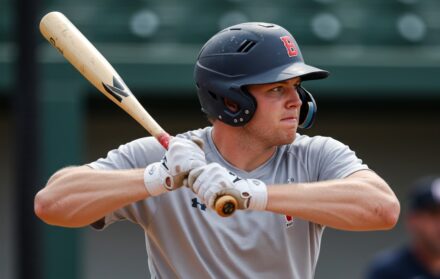
Crush the Ball: Mastering Hip Rotation for Baseball Power
Every time you see a slugger smash a baseball hundreds of feet over the outfield fence, there’s a hidden but crucial secret at work: powerful hip rotation. While upper-body strength and hand-eye coordination often dominate conversations about hitting, learning proper hip rotation for baseball power can be the difference between a routine fly ball and a game-changing extra-base hit.
Whether you’re a budding little leaguer or a seasoned veteran chasing the next boost in performance, honing your hip movement is the key to unlocking new levels of force and bat speed. It’s not merely a question of pivoting; it’s about harnessing the kinetic chain—transferring energy from the ground through your legs, hips, and core, all the way up to your hands and the barrel of your bat.
Despite its importance, hip rotation remains one of the most undervalued aspects of hitting. Many players assume that bigger biceps or a heavier bat automatically translate to power. In reality, force generated through your hips can multiply the potential energy in your swing more effectively than raw muscle alone. This synergy between lower and upper body is what separates consistent power hitters from those stuck at average exit velocities.
The good news is that hip rotation is a learned skill, refined through consistent drills, strength training, and a deep understanding of body mechanics. In the pages that follow, we’ll delve into the nuances of rotating your hips for optimal impact, laying out everything from basic biomechanics to advanced exercises, so you can truly crush the ball.
The Foundation of Baseball Power: Understanding Hip Rotation’s Role

Hip rotation isn’t an isolated movement; it’s the silent engine that drives many of the movements you see in top-tier hitters. When you watch slow-motion replays of an elite home-run swing, notice how the hips fire before the arms follow through. The synergy starts with a weight shift onto the back leg, then transitions as the front hip opens, unleashing torque that snaps the bat head through the zone. This interplay between back and front hip dictates not only the speed of your swing but also the direction and loft of your hit.
In a broader sense, hip rotation works as part of the kinetic chain, a term that describes how each segment of the body activates in sequence to produce maximum force. Without strong engagement of the hips, the chain remains incomplete or “broken,” causing you to rely overly on your arms. That’s akin to trying to throw a fastball using only your wrist. You might generate some power, but you’ll never reach your full potential.
The logic behind hip rotation is straightforward: your lower body is stronger than your upper body, thanks to powerful muscles in the legs and core. By rotating your hips effectively, you tap into that strength. Think of it like winding up a spring. When you coil your hips, you store energy; when you uncoil, you release that energy in an explosive burst. Hitters who neglect hip rotation often find themselves stuck at a certain performance plateau—hitting decent line drives but rarely driving the ball deep or pulling it with consistent authority. Once you master the fundamentals of hip rotation, you’ll see improvements not just in raw power but also in swing stability and consistency, ultimately turning you into a more complete and dangerous hitter.
The Anatomy of Hip Rotation: Mechanics and Muscle Groups
Hip rotation involves a blend of muscular coordination and skeletal alignment that, at first glance, might appear complex. However, understanding the specific mechanics simplifies the process. Essentially, the motion pivots around the ball-and-socket joint of the hip, which allows your legs to rotate inward or outward. When you swing a baseball bat, the rotation is primarily external rotation of the back hip and internal rotation of the front hip, facilitated by muscle groups in your thighs (quadriceps, hamstrings), glutes, and core.
- Back Hip Loading At the start of your swing, you often “load” into your back hip. This loading is basically a controlled backward shift that flexes and stabilizes that side of your lower body. During this load, the glute on the back side is actively engaged, supporting your body weight and creating torque.
- Front Hip Opening As you transition from load to the forward swing, your front hip starts to open toward the pitcher. Muscles like the hip flexors and obliques help rotate your pelvis, guiding your torso to face the pitch. This is where your entire core, especially your abdominal muscles, works to rotate the trunk in sync with the pelvic movement.
- Core Stabilization and Transfer Throughout hip rotation, your core acts as a stabilizer and a conduit for power. The twist in your torso is not random; it’s orchestrated so that the force generated by leg drive and pelvic rotation continues upward. If your core or lower back is weak or inflexible, you’ll lose energy at this junction.
- Completing the Chain Once the hips are fully engaged, the upper body—shoulders, arms, and hands—follows through. The last link in the chain is the bat making contact with the ball, ideally with maximum velocity. Properly sequencing these events ensures minimal energy is wasted, and you can direct the greatest possible force into the baseball.
When these stages flow together seamlessly, the result is a swing where your hips are the catalyst, and your arms and bat are merely the final instruments. Conversely, any malfunction in these muscle groups—be it tightness in the hips, weak glutes, or a lack of rotational core strength—can derail the process, reducing your potential impact. That’s why advanced hitters often dedicate entire workouts to flexibility and strength in their hips, glutes, and core, aiming for that elusive perfect synergy.
Identifying Common Pitfalls: Why Hip Rotation Falters

Even when players grasp the importance of hip rotation, a range of issues can hinder its execution. Some errors stem from physical limitations—tight hip flexors or poor ankle mobility—while others boil down to flawed habits or misconceptions about swinging. Recognizing these pitfalls is the first step to correcting them, paving the way for more efficient, explosive motion.
- Arm-Dominant Swing: In an effort to muscle the ball, some hitters rely too heavily on their arms. This can overshadow the lower body, limiting hip rotation. The result is a choppy swing that may produce contact but lacks real force.
- Late Hip Turn: Timing is everything. If you delay opening your hips until after your shoulders start to rotate, you rob yourself of the torque that arises from hips leading the motion. You’ll typically see weak ground balls or pop-ups because your swing is jammed.
- Over-Rotation or “Flying Open”: On the flip side, some hitters open their hips too soon, leaving their hands behind. This “flying open” can cause you to pull off the ball or roll over grounders. Striking a balance in timing is key: too early or too late both hamper solid contact.
- Locked Lower Back: Rigid or inflexible backs hamper the rotational chain, often transferring undue stress to shoulders or arms. This can manifest as back pain or inconsistent swing paths, especially on inside pitches where more torque is required.
- Poor Weight Transfer: Sometimes the hips can rotate, but if your weight remains stuck on the back foot or shifts too violently to the front foot, you lose stability. Ideal rotation happens in harmony with a forward weight shift that never compromises balance.
Each pitfall can often be diagnosed through video or a coach’s eye. If you notice you’re consistently pulling off pitches or hitting weak grounders, consider whether your hips are rotating in the correct sequence. Similarly, if you feel tension in your lower back or limited motion in your stride, you may need targeted flexibility and strength interventions.
Drills and Techniques to Develop Hip Rotation for Baseball Power
Refining hip rotation isn’t just about thinking “rotate more.” It requires structured, progressive drills that integrate muscle memory into your swing. Below are some specialized exercises to expedite this learning curve:
Dry Hip Rotation
Stand in your batting stance, minus the bat. Practice rotating your hips as if you were about to swing, but keep your arms folded or relaxed at your sides. Concentrate on the feeling of your back hip coiling and uncoiling. This helps embed the movement without the distraction of the arms.
Resistance Band Torso Twists
Anchor a resistance band at waist level. Hold the other end with both hands, stepping away to create tension. Assume a slight athletic stance. Rotate your hips and torso against the band’s pull, mimicking your swing path. Focus on firing your hips first, then letting your shoulders follow. This build-up of tension and release closely parallels the real swing dynamic.
Step-Through Swings
Place a tee at home plate. Start your stance a few inches behind your normal position, so you have to step forward into the box. As you take that step, pivot your hips into the swing. This drill forces a more aggressive hip drive, helping players who struggle with an arm-dominant motion.
Medicine Ball Rotational Throws
Use a light medicine ball (3-8 pounds) and stand sideways to a wall. Rotate your hips, fling the ball at the wall, catch it on the rebound, then repeat. The ballistic nature of the throw encourages a forceful hip turn, training you to transfer leg power through your core.
One-Knee Drill
Kneel with the back knee on the ground, front foot planted, and hold a bat or a short dowel across your shoulders. Practice rotating your torso and hips together in a mock swing motion. With one knee down, you emphasize upper-body twist driven from the hips, reinforcing the concept that hips lead, shoulders follow.
Consistency across these drills is paramount. Doing them once won’t magically fix your mechanics. Incorporate them as part of your routine, cycling through short sets every practice or off-day workout. Over multiple sessions, your body begins to internalize the correct sequence, so when you return to a full swing with a pitched ball, your hips automatically snap through on time.
Integrating Hip Rotation with Upper-Body Mechanics

Hip rotation might be the engine, but the rest of your body—core, shoulders, arms, and hands—must be in sync to transform rotational power into a well-struck ball. A major challenge arises when players isolate lower-body improvements but fail to harmonize them with their upper half. This misalignment typically appears as disjointed swings, where the hips might rotate effectively, but the arms lag behind or fail to find the correct slot.
One strategy is to chunk the swing into manageable phases—stance, load, foot plant, hip turn, shoulder rotation, and finally the hands releasing. Spend time practicing each phase in slow motion, ensuring a smooth pass-off of energy from the hips to the shoulders. During batting practice, consider focusing on a specific segment, like the moment after front foot contact. Is your front hip open enough to let your back hip drive the swing? Does your front shoulder stay slightly closed to keep your eyes on the pitch, or are you flying open?
Video feedback can be invaluable here. Film yourself from the side and from behind home plate, analyzing how your hips and shoulders move relative to each other. If you see your shoulders rotating at the same time or even ahead of your hips, you’re bleeding potential power. If your hips look explosive but your bat is lagging, you might not be connecting your upper half to the strong rotation properly.
Integrating upper-body mechanics also involves refining your scapular load and hand placement. As your hips begin to rotate, your hands should still be somewhat “loaded,” waiting to whip forward at the last instant. This lag in the hands relative to the hips is what fosters “bat whip,” a major contributor to exit velocity. Over time, mastering this interplay of hip rotation and shoulder-arm synergy becomes second nature, producing a swing that’s both powerful and adaptable to different pitch locations.
Strength and Mobility Training: Supporting Explosive Hip Rotation
Hip rotation isn’t solely a technical matter; it’s also a product of strength, flexibility, and mobility. Even if you understand the correct sequence, tight hip flexors or weak glutes can hamper your performance. Incorporating targeted strength and mobility work into your regimen ensures your body can physically execute the powerful rotation you’re aiming for.
Lower-Body Lifts
Exercises like squats, deadlifts, and lunges develop the quads, hamstrings, and glutes, which anchor your rotating power. Lunges in particular mimic the unilateral aspect of a swing, where one leg bears more weight momentarily. Focus on form and progressive overload—start with moderate weights, then gradually increase as your technique solidifies.
Rotational Core Work
Beyond standard planks or crunches, incorporate rotational moves: woodchoppers with cables, Russian twists on a stability ball, or even lateral medicine ball throws. These moves replicate the transverse plane motion of a swing, strengthening obliques and deeper trunk muscles.
Hip Mobility Drills
A common barrier to rotation is restricted internal or external hip rotation. Simple mobility routines like the pigeon pose (from yoga) or dynamic hip openers can help. Resistance band hip distractions also loosen up the joint. Devote at least 5-10 minutes daily to dedicated hip mobility, particularly if you feel stiff after long practices or weightlifting sessions.
Glute Activation
Weak or inactive glutes undermine the entire chain. Consider bridging exercises or clamshells to activate your glute medius and glute maximus. Over time, stronger glutes significantly improve your ability to “sit back” and explode through the rotation without losing balance.
When integrated effectively, these strength and mobility elements create a body primed for rotational explosiveness. If you skip them, you risk technique plateau or even injury, because your system can’t handle the forces you’re trying to generate. By regularly testing your range of motion and adding progressive overload, you’ll see the results manifest not only in your hitting power but also in resilience—fewer aches and a consistent ability to rotate through each at-bat.
Converting Practice Gains into Game-Day Performance
Translating smooth practice swings into consistent in-game success is the ultimate challenge. Even the purest hip rotation can unravel when facing live pitching, especially under pressure. That’s why mental conditioning and situational awareness go hand in hand with physical mechanics. If your hips freeze up the moment you see a curveball, your well-drilled rotation does little good.
A practical way to bridge the gap is game simulation. Ask your BP pitcher or a pitching machine to mix up speeds and locations, forcing you to adapt your rotational sequence on the fly. Visualize actual game scenarios—like a 2-1 count where you anticipate a fastball in a specific zone. Step into the box, gather your stance, take a breath, and let your hips lead the swing as soon as you commit. If you sense your arms taking over or your hips lagging, step out, reset, and remind yourself of the sequence you’ve ingrained.
Confidence also plays a role. If you’ve done hundreds of reps focusing on hip rotation, trust that muscle memory. Overthinking can stifle fluid movement. Instead, approach each pitch with a calm, single-minded focus: see the ball, rotate the hips, let the swing flow. Over time, you develop what coaches call “quiet confidence”—the knowledge that your mechanics are sound and you just need to apply them. This synergy of mental readiness and robust technique is what leads to truly powerful, consistent hitting.
Conclusion: Embracing Hip Rotation as the Keystone of Baseball Power

Ripping a line drive off the wall or sending a ball soaring beyond the outfield fence might appear to be purely an upper-body feat, but beneath those dramatic hits lies a sophisticated dance of lower-body mechanics. If you genuinely want to crush the ball, mastering hip rotation for baseball power is more than an optional enhancement—it’s a defining cornerstone. By honing your lower-body coordination, you’re not just adding a few extra feet to your hits; you’re transforming the entire character of your swing.
Throughout this article, we’ve explored the deep interplay between stance, load, weight transfer, and upper-body synchronization—each element anchored by explosive hips. We’ve also traced common pitfalls, from lazy weight shifts to premature opening, and outlined targeted drills to correct them. Whether it’s medicine ball throws to fortify rotational explosiveness or deliberate slow-motion reps to internalize the correct sequence, each step cements a foundation for unstoppable power.
Ultimately, baseball is a game of continuous refinement. Even seasoned pros repeatedly revisit their hip mechanics to fend off slumps or generate that extra edge. By threading strength and mobility work into your routine, adopting a strategic approach to practice, and carrying that confidence onto the field, you can elevate your hitting beyond what raw arm strength could ever yield. When your hips seamlessly rotate, transferring force up the chain to your hands, every pitch becomes an opportunity to do real damage. Embrace this knowledge and consistently apply it, and before long, you’ll find your hardest hits feel astonishingly effortless—an unmistakable sign that your hip rotation has arrived.





